
Purely imaginary!
Coot-ie: n. informal… US. a children’s term for an imaginary germ or repellent quality transmitted by obnoxious or slovenly people.
JULY 4, 2019 marks the thirtieth anniversary of my departure from the Society of St. Pius V (SSPV).
Most traditional Catholics know that some sort of a conflict occurred many years ago among the priests who had left SSPX in 1983-84 and later formed the Society of St. Pius V (SSPV).
Few trads, however, know what caused the SSPV dispute. Fewer still know why the four priests who ultimately remained in SSPV (Frs. Kelly, Jenkins, Mroczka and Skierka), as a matter of policy, still refuse sacraments to lay Catholics affiliated with former SSPV priests such as Bp. Donald Sanborn and myself.
Normally, one would pass over in silence the details of such an ancient controversy. But thirty years on, a new generation of SSPV clergy still enforces this draconian penalty on a new generation of young traditional Catholics, and this naturally ought to raise a number of unsettling questions:
- Why do you — a faithful twenty-year-old traditional Catholic from my parish or Bp. Sanborn’s, say — have to hide your affiliation if you’re traveling and want to receive Communion at an SSPV mission?
- Why, if you’re a twenty-year-old former graduate of Fr. Jenkins’ school in Cincinnati, does Fr. Jenkins forbid you to receive Communion at Bp. Dolan’s parish when it’s convenient to do so?
- Why, if you are a parishioner at St. Gertrude the Great, does Fr. Jenkins refuse to allow you to be a godparent for a nephew baptized at his church? (This incident actually occurred in late June, 2019 as I was writing this article.)
- Why, if you’re a priest just ordained by newly-consecrated SSPV Bp. James Carroll, are you expected to enforce these penalties or prohibitions on your contemporaries, even though you can’t find the “crimes” they punish described in any pre-Vatican II canon law or moral theology book?
These practices, as we shall see, are all applications of what I call the “SSPV Spiritual Cooties Rule.”
Like the cootie of children’s playground fame, the SSPV cootie is an imaginary creature. You “catch” this cootie infestation by receiving sacraments from a traditional Catholic priest who himself caught a cootie earlier — from someone that SSPV declared cootie contaminated. It makes no difference how long in the past the contamination occurred. The rule has no statute of limitations, and the SSPV cootie has a very, very long arm.
When you step back from it even a bit, it is obvious that the Cooties Rule is nothing more than a punishment based on guilt by association. None of us who are old enough to remember the pre-Vatican II Church can ever remember anything like this going on.
Where did the rule come from and why is it still in place? The answer is quite different from what you might at first imagine, and the thirtieth anniversary of my departure from SSPV is the perfect occasion for me to explain.
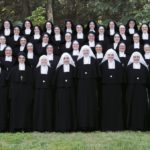
The Daughters of Mary, Round Top NY. No canonical status and merely private vows.
The Daughters of Mary
In early 1984, a year after our expulsion from the Society of St. Pius X, Fr. Kelly announced he was going to found his own order of nuns, the Daughters of Mary. He promptly purchased a property for it in Round Top, New York, an isolated location nowhere near our numerous mission Mass centers and a three-hour drive from our Oyster Bay headquarters.
Before proceeding further, we should be clear on the principles in church law that apply to founding an institution like this in the post-Vatican II era.
Lacking ordinary jurisdiction (the hierarchical ruling power that a diocesan bishop would have, for instance), no traditional priest or bishop has the power to establish a legally constituted religious order or religious congregation. A traditional priest or sister can only establish an organization of persons who imitate the rules of traditional orders and congregations.
In organizations like this, the vows that members take have no public canonical status in church law. Instead, lacking this public status, their vows are called “private” vows, even if a member pronounces them before a thousand people. They have the same status as a vow you or I might make to, say, give up coffee or pizza — and just like a no-pizza vow, a vow in the Daughters of Mary or any organization like it can be dispensed by any confessor for a sufficient reason.
With this in mind, we turn to the circumstances of the founding of the Daughters of Mary. Fr. Kelly gave his priest-colleagues (at that point, Frs. Sanborn, Dolan, Cekada, Jenkins, Collins, Zapp and Skierka) no real choice in the matter whether the convent should be founded or not. From the beginning, Fr. Kelly designed it as a one-man show; he and he alone would decide everything about the institution: its organization, its apostolate and its rules. There was no outside control on what Fr. Kelly would decide — especially from the other priests.
As a former religious myself, I considered this arrangement extremely dangerous. It was the recipe for establishing a closed personality cult, and there were several of those in the traditionalist movement already.
Soon, all the classic signs a cult started to emerge: the hero-worship of the great father-founder, Fr. Kelly’s secretiveness, his statement that “The best way to motivate people is through guilt and fear,” spiritual advice from outside priests being painted as unreliable, potential members being told they were obliged to join the Daughters of Mary or face losing their souls, portraying departure from the organization as ingratitude to the Sacred Heart, and Fr. Kelly’s duplicitous and dissembling statements to fellow priests.
Coupled with this, Fr. Kelly employed another cult-leader tactic. The Great Founder, while strict on measures to induce guilt, fear and absolute group loyalty in his followers, would be surprisingly liberal on other matters such as recreational activities, and he avoided instituting ascetical/disciplinary practices that were a normal part of pre-Vatican II religious life. The purpose was to relieve the inevitable pressure from the cult-building techniques in other aspects of common life.
And finally, there was the product. When I was Pastor of St. Pius V Chapel on Long Island and the Daughters of Mary arrived to teach at our school around 1987, I was not impressed. I found them liberal, lazy, and uncooperative.
I was not alone in my concern. Other priests familiar with the operation of the convent — Frs. Dolan, Collins and Ahern — noticed many of the same problems as well, as may be seen in our June 29, 1989 letter to Fr. Kelly.
The situation came to a head in July 1989. Fr. Kelly summarily purged one of the founding sisters (the blood sister of another priest colleague) who had become disenchanted with the direction the Daughters of Mary was taking. Conflicts like this were common in the founding of many women’s religious orders in the U.S; the sisters who departed would usually go off to found another order, perhaps with the help of another priest, and that would be the end of the story.
But since he was running a cult, Fr. Kelly insisted that no other priest would have the right to take in the former Round Top sister or allow her to continue religious life, and then, as is typical with the leaders of such organizations, threatened lawsuits, public denunciations and general ruin against anyone would cross him.
By this time, Fr. Dolan and I were fed up with Fr. Kelly’s threats, duplicity and cult-building tactics — this was the stuff of the Ranjeeshpuram cult and Scientology — so we resigned from SSPV. We wouldn’t be the last priests to do so.
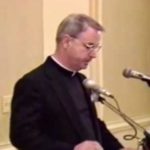
Rev. Clarence Kelly, 1991. Revenge was the reason.
The Original Motives for the Penalty
Here we come to the original motives for the penalty that SSPV has been inflicting on the laity for thirty years now.
It started with revenge. Like the Bhagwan Ranjeesh and L. Ron Hubbard, Fr. Kelly began a campaign of scorched earth destruction aimed at opponents of his cult. The former Round Top sister and those who supported her had to be destroyed, discredited or intimidated into silence.
In August 1989, therefore, Fr. Kelly announced it would be a “mortal sin” for a priest to give Holy Communion to the sister who had left. Not only that, but St. Gertrude the Great parishioners who merely received Communion from any priest who did — i.e. Fr. Dolan and me — would also then be committing “mortal sin” by being “in communion with” the “mortal sin” of the sister who had left.
From the perspective of canon law and Catholic moral theology, this declaration was pure fantasy — every bit of it. For starters, the the law of the Church allows a Catholic to receive a sacrament from even an excommunicated priest “for any just cause” (canon 2261). Moreover:
- The Daughters of Mary was nothing more than a Fr. Kelly creation, so no traditional Catholic was obliged to recognize its existence or defer to the rulings of its fearless leader “under pain of mortal sin.”
- Any vows in the organization were “private” — the canonical equivalent of a layman’s no-pizza vow — and no layman or priest was obliged to treat them otherwise.
- Any confessor can dispense from such vows with a sufficient reason.
- The sister who blew the whistle on Round Top had just as much canonical “right” to found her own religious order as Fr. Kelly did.
- In any case, mortal sins (especially invented ones) can’t be picked up from others at the communion rail like so many spiritual cooties.
Lay people, of course, wouldn’t know that the Kelly-created notion of “contagious mortal sin” — nothing more than guilt by association, in fact — was complete nonsense. But the right combination of emotional appeals and demagoguery could probably get a good number of gullible laymen to believe in — and most importantly, to fear — the imaginary spiritual cooties.
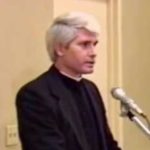
Rev. William Jenkins, 1991. Base clerical ambition.
Enter Fr. William Jenkins. Fr. Dolan had invited him to Cincinnati in 1984 to be Principal of the St. Gertrude the Great parish school. For Fr. Jenkins the promulgation of the Kelly Cooties Rule was like catnip. He immediately jumped on the “mortal sin” bandwagon.
His motive was all too obvious. Ever since his arrival in Cincinnati, Fr. Jenkins had resented Fr. Dolan’s insistence that all aspects of the school operation be completely integrated into the rich and long-established liturgical life of the parish. Telling laypeople that they would commit mortal sin by assisting at Mass at St. Gertrude’s would give Fr. Jenkins the righteous-sounding pretext he needed to take full control of the parish school for himself, and to open an independent Mass center in Cincinnati. (He already had quite a nice church of his own in Cleveland.)
Like Fr. Kelly, Fr. Jenkins employed an array of classic cult manipulation techniques: long, rambling sermons and speeches (obviously unprepared) delivered in his trance-inducing basso profundo voice; public complaints about his supposed health problems that aimed at winning pity and sympathy; late-night phone calls to check up on the loyalty of supporters; heavy doses of empty bluster and indignation (“Can you imagine? Can you really imagine?”); not-so-subtle appeals for pats on the head (“I’ll leave the school if the people want me to!” “Oh, no, Father, please, not that!”), and habitual late starts for Masses and other public activities (because poor Father is just so busy or so sick).
(Those who have seen Fr. Jenkins in action even recently will recognize that his methods have not changed.)
Fr. Jenkins’ local campaign succeeded to the extent that he was soon able to establish a Mass center of his own and eventually, a church in Cincinnati, Immaculate Conception, Norwood.
Thus the original motives of those who created the SSPV Spiritual Cootie Rule: For Fr. Kelly, it was scorched earth revenge against challenges to his cult; for Fr. Jenkins, it was simple and base clerical ambition.
If you think my assessment is severe, it is nothing compared to the pain, the division and the heartbreak that the revenge and ambition of these two men have inflicted on traditional Catholic families for thirty years.
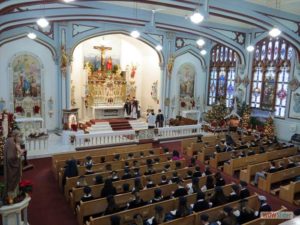
CMRI’s Mt. St. Michael, Spokane WA
The CMRI Group
The foregoing brings us to the end of 1989. Not everyone in Cincinnati or its missions bought the original Kelly-Jenkins “mortal sin” accusation. Frs. Kelly and Jenkins then needed to invent other mortal sins in hopes of getting people to avoid us.
In December 1989, some laymen from Columbus who had been affiliated with the traditionalist CMRI (or Mount St. Michael) group in Spokane, Washington, approached Fr. Dolan and me, and asked if we would give them sacraments. In the Fr. Kelly universe, to do so was absolutely forbidden — yet another mortal sin, because, Father claimed, those affiliated with CMRI must be considered “Old Catholics” (i.e., descendants of a 19th century schismatic group).
But having seen Father simply make stuff up earlier that year, I decided to research the historical, canonical and moral issues myself. Here, too, I discovered Fr. Kelly was spouting nonsense. There was no principle in the Church’s canon law, sacramental theology or moral theology that could justify either calling these people “Old Catholics” or refusing them the sacraments. (For a brief explanation see here.) So we treated the CMRI laity like the Catholics they were, who according to canon 853, “may and must [potest et debet] be admitted to Holy Communion.”
The Cootie Patrol went crazy: receiving sacraments from traditional Catholic priests who were “in communion with” CMRI? Yet another mortal sin for Catholics who frequented our communion rails!
(If you really think this particular cootie is anything more than imaginary, you can watch Fr. Jenkins flounder to defend its existence in a 2002 public debate with me here; references to the documentation from moral theologians and canonists that I cited in the debate and passed out to those attending may be found in my article The Great Excommunicator. The impressive-looking portfolio Fr. Jenkins brought with him, I noted, contained only blank sheets of paper.)
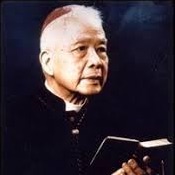
Abp. P. M. Ngô-dinh-Thuc
Abp. Thuc’s Consecrations
Anyone who knows a bit about the history of the traditionalist movement usually knows that in the 1980s, I was skeptical about validity of the episcopal consecrations that Abp. Pierre-Martin Ngô-dinh-Thuc conferred in 1981.
But in Catholic sacramental theology, personal doubts must give way to objective principles, and emotional prejudices must give way to verifiable facts interpreted according to those principles, as I explained in the video below.
For the sacramental certificate and photos I mention in the video, see here, and for testimony about the archbishop’s mental acuity after the 1981 consecrations, see the account here of someone who lived and interacted with him every day.
Some favorite anecdotes on the latter point: Abp. Thuc teaching himself to speak fluent Spanish, Abp. Thuc teaching Latin to the seminarians, and Abp. Thuc instituting the practice of conducting all conversations in Latin on one day each week. Remember, this was after the 1981 consecrations, for which Fr. Kelly expected us to believe that the archbishop was probably a drooling loony incapable of conferring a sacrament.
By mid-1990, I therefore saw no problem working with properly-trained traditional Catholic clergy who derived their orders from Abp. Thuc.
But for Frs. Kelly and Jenkins, this represented yet another “mortal sin” to add to the list for each layman who approached my communion rail — Fr. Cekada was “in communion with invalid Thuc clergy.” So at this point, you were incurring three mortal sins per trip.
The cootie count was mounting!
 “Scandalous Associations!”
“Scandalous Associations!”
Toward the end of 1990 and the beginning of 1991, it was gradually becoming obvious to my former priest-colleagues in SSPV and to many members of the laity that the Kelly-Jenkins arguments against the validity of the Thuc consecrations were worthless.
To head this off, Frs. Kelly and Jenkins tried to summon up yet another cootie: Abp. Thuc’s “scandalous associations.” If the archbishop did something imprudent, wicked or even merely questionable back in the 1970s or ’80s, that deed became another spiritual cootie which automatically crawled onto you at the St. Gertrude the Great communion rail in the 1990s (or in 2019, for that matter).
So now the count was four mortal sins per trip. You were “in communion with” sacrilegious vows, Old Catholic schismatics, invalid clergy and scandalous deeds. Quite a load! And if one of the few remaining SSPV Fathers spotted the cootie when you went to one of their chapels, no communion, no absolution, and no godfathering the nephews or nieces at baptisms for you, buster!
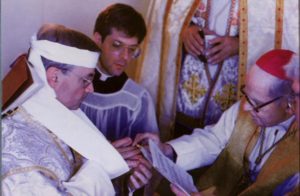
Bp. Mendez’s secret consecration of Bp. Kelly in 1993.
Bishop Alfred Mendez
Frs. Kelly and Jenkins’ attempt to sell this idea — “scandalous deeds” — would turn out to be pure and near-comical hypocrisy. By mid-1990, the Fathers were already in the process of getting their group deeply involved with Bp. Alfred Mendez, a worldly, retired Novus Ordo bishop, who was a teeming hive of scandalous associations himself. Bp. Mendez would secretly ordain two priests for SSPV in September, 199o, and then secretly consecrate Fr. Kelly a bishop in September, 1993.
Just about everything that Frs. Kelly and Jenkins had been denouncing as “scandalous” in Abp. Thuc, their own Bp. Mendez was actually guilty of — and much, much worse.
So when Fr. Kelly’s secret consecration was revealed in 1995, I assembled a lengthy list of what Bp. Mendez had been up to. (See here) He had advocated nuns’ liberation, the leftist Cursillo movement, “lay ministry,” ordaining married men permanent deacons, combining all traditionalist groups into one giant entity under John Paul II, and a married priesthood. He celebrated the Novus Ordo publicly; raised money for the near-atheist Notre Dame University and constantly boasted of his many worldly connections (e.g., Hollywood and Las Vegas).
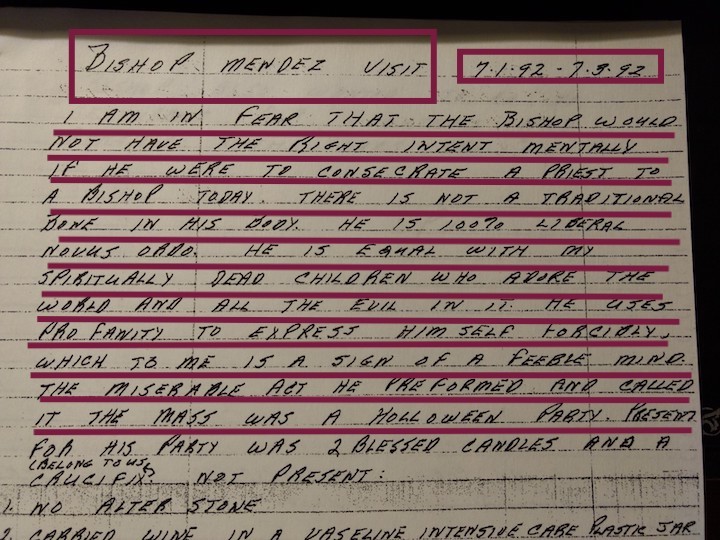
1992: Bp. Mendez visits and scandalizes a lay couple.
In July 1992, a year before he consecrated Fr. Kelly, Bp. Mendez spent three days with an old-time traditionalist couple in the Midwest. Having heard that the prelate was somehow a traditionalist, they were shocked by his odd behavior, and indeed, the liturgical abuses he perpetrated when he celebrated a supposedly “traditional” Mass for them. Bp. Mendez told them that the Church “has too much doctrine,” that doctrine “is not so important,” and that he went on cruises to serve as a chaplain “for all denominations.” His host summed up his impression of Bp. Mendez, then 84, this way.
“I am in fear that the Bishop would not have the right intent mentally if he were to consecrate a priest [to be] a bishop today. There is not a traditional bone in his body. He is 100% liberal Novus Ordo. He is equal with my spiritually dead children who adore the world and all the evil in it.”
My purpose for compiling the depressing list was not to run down an old bishop: the whole Novus Ordo episcopate, after all, hit the skids after Vatican II. It was simply to show people in the SSPV orbit that Frs. Kelly and Jenkins’ principles were false because they themselves did not follow them.
But the real clincher for the Mendez affair was this: Whenever Frs. Kelly and Jenkins solemnly recited Abp. Thuc’s “scandalous associations,” the cherry on top was inevitably their accusation that, in the 1970s, the archbishop consecrated to the episcopacy one Jean Laborie, supposedly “a known homosexual.” You were supposed to gasp and shake your head when the phrase was uttered. Fr. Kelly repeated it at least seven times in his book length anti-Thuc tirade, The Sacred and the Profane.
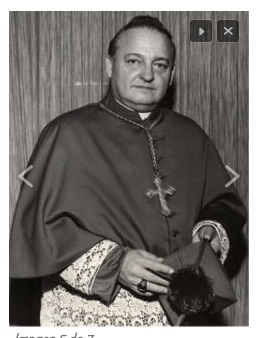
Most Rev. Miguel Rodriguez: Bp. Mendez’s and Bp. Kelly’s own “Jean Laborie.”
But Bp. Mendez, it turned out, had done the same thing in 1967, when he consecrated Miguel Rodriguez to be his hand-picked successor as Bishop of Arecibo, Puerto Rico. Bp. Rodriguez — his nickname was “Lili” — treated the young clergy of his diocese “like a harem,” and many of them emigrated to Miami, where they would wind up as major figures in the Novus Ordo sex abuse scandals. His conduct was so outrageous that the Novus Ordo Vatican removed him and sent him to a monastery. (For details, see the end of the article here.)
So if “scandalous associations” are indeed spiritual cooties, Bp. Kelly, Fr. Jenkins and anyone affiliated with SSPV are positively covered with them. A cootie for the goose is a cootie for the gander, right?
But fortunately for poor sinners, as well as goofy bishops, canon law and Catholic moral theology simply don’t work that way. When it comes to conferring or receiving sacraments, the good Fathers and their lay followers are really no more “tainted” by their old bishop’s thirty-year-old mistakes than I am by Abp. Thuc’s.
Which is to say, not “tainted” at all. So for Bp. Kelly, Fr. Jenkins and their followers to continue to pretend otherwise is hypocrisy.
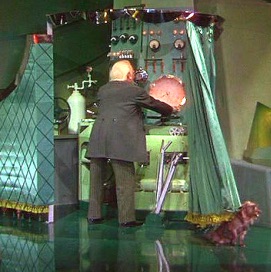
On the Cooties Rule, it’s curtains for the Wizard…
And My Fellow Priests?
At this point in the story, one might ask how the Kelly-Jenkins cooties campaign played with the rest of the priests who remained in SSPV? Initially, some priests bought into or silently tolerated it. But one by one, they started to realize that Fr. Kelly’s confidently asserted claims about mortal sin, communion with schismatics, doubtful sacraments and “scandalous associations” had nothing to do with canon law and everything to do with manipulation. When it came to Fr. Kelly’s thundering and fulminations, each priest had his own “Wizard of Oz” moment.
Thus, Frs. Sanborn, Collins, Zapp, McMahon and Ahern all eventually voted with their feet against these crazy policies, and followed Fr. Dolan and me out of the Society of St. Pius V. All admitted CMRI laity to Holy Communion and all recognized the validity of the Thuc consecrations. Of the eleven original priest-members of SSPV, this left only Frs. Kelly, Jenkins, Mroczka and Skierka, whose sister was a Round Top nun.
But eventually even Fr. Jenkins would feel Fr. Kelly’s wrath over the Round Top nuns. Fr. Jenkins had installed a group of them to teach at the school attached to his rival church, Immaculate Conception in Norwood. Fr. Jenkins got into a tiff with them by insisting they follow his policies. The nuns resisted, and Fr. Kelly pulled them out of the school in the middle of the academic year.
And though Fr. Jenkins still firmly adheres to the Spiritual Cooties Rule, it is difficult not to think that Fr. Kelly has put him, too, on more or less permanent punishment for crossing the nuns. Since the 1995 announcement of Bp. Kelly’s episcopal consecration, he or his successor, Bp. Santay, have visited Fr. Jenkins’ church for confirmations only twice that I’ve ever heard of — that’s twice in twenty-four years.
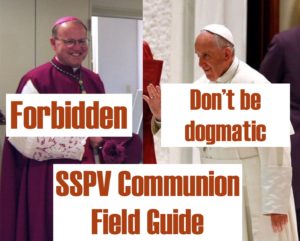
Anyone see a problem here?
In Communion… But With Whom?
The attention that SSPV paid to sniffing out fictional “communion” with these various perceived boogeymen also blinded its clergy and followers to the one type of communion that canon law and Catholic moral theology does condemn: communion with heretics or schismatics, or actively assisting at Mass where their names are put into the Canon or other liturgical prayers.
(For an explanation of the linguistic, canonical, moral and theological reasons against doing so, see my lengthy study here, and a resumé of it here.)
But for SSPV, as long as you observed the Cooties Prime Directive and refused communion to St. Gertrude the Great or Most Holy Trinity types, how you answered questions like the following never really mattered:
- Is the Holy See vacant? Nothing more than “matter of opinion.” No big deal one way or the other. You can’t be “dogmatic” about it.
- Assisting at Masses where Bergoglio’s name is put into the Canon? No real problem, even though inserting the name is “disgusting,” and “I would not do it myself.”
- Attending SSPX Masses, even though they’re virtually part of the Conciliar Church? OK if there seems to be nothing else around.
- Going to SSPX to receive confirmation from one of their bishops? No problem. Your choice.
- An SSPV gal getting married at a traditional Mass in a Novus Ordo parish? OK if an old Novus Ordo priest performs the ceremony, and it would avoid objections from the guy’s conservative, non-traditionalist relatives.
On these issues and others, Frs. Kelly, Jenkins and their followers are still stuck back in the early 1980s. This is because nearly all the sedevacantist authors who produced serious, well-researched studies on the great questions that traditional Catholics face today concerning dogmatic theology, ecclesiology, canon law, sacramental theology, the Vatican II popes, the Novus Ordo sacraments, and the Society of St. Pius X — whether Bp. Donald Sanborn, the Institute of Good Counsel Fathers, the writers on Novus Ordo Watch, the CMRI priests or myself — whatever differences they may have on other points, nevertheless reject the principles behind the Cootie Rule as absurd and non-Catholic.
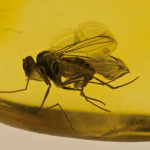
Never changes HIS positions either!
For SSPV to follow the lead these authors have given on other issues would necessarily imply that the same authors could be correct in universally rejecting the Cooties Rule, too — and you couldn’t have that, could you? Better your brain should be like a fly in amber.
And as regards SSPV clergy engaging in serious theological research and writing coherent studies of their own on the big issues, I’ve never seen any at all. The most you seem to get are droning videos from Fr. Jenkins with no theological meat and plenty of indignation. Their actual content can usually be summed up in two paragraphs.
Moreover, just as a few liberal escape valves relieve cult pressures for those within the Daughters of Mary, so too, a few of these for the laity (on the pope, SSPX Masses or your children getting married at an Indult Mass) can relieve the pressure that they feel because of the Cooties Rule.
Locally in the Cincinnati area, Fr. Jenkins for years studiously avoided educating his parishioners on sedevacantism and the pope question, even dissembling to some that “we are not really sedevacantists.” I’ve seen the effects in young people I’ve encountered from his parish; some had no idea about what sedevacantism was, or why the pope issue was important for a Catholic. Recently, I’ve heard about young people who graduated from Fr. Jenkins’ school but regularly frequent the local “traditional Mass” sponsored by the Novus Ordo Archdiocese. And why not, if the pope question is not even important enough to talk about?
There is also no doubt in my mind that Frs. Kelly and Jenkins’ practical indifference to the pope question is tied to their involvement with Bp. Mendez. The man was up to his eyeballs in the Novus Ordo religion. If you can justify getting yourself consecrated a bishop by someone like that and hold him out as a proper Catholic, you can hardly forbid your parishioners to avoid that bishop’s Novus Ordo co-religionists.

The SSPV Laity: Singing the Kelly-Jenkins tune — but not necessarily believing the words.
Lay Attitudes towards the Penalties
Over the past thirty years, I’ve had ample opportunity to form my impressions about the attitudes that lay Catholics in SSPV circles have towards the Cooties Rule.
On one end of the spectrum, many SSPV lay followers may be unaware of its existence, or live in places where it will have no practical effect on them.
Others know of the rule, but routinely and rightly ignore it as absurd. They may assist at SSPV Masses either regularly or only occasionally, but they have no hesitation to confess to or assist at the Masses of “tainted” clergy like yours truly and his colleagues. But for some lay people like this, I am told, Fr. Jenkins looks the other way and makes what is dryly referred to as a “net worth exception.”
On the opposite end of the spectrum is a core of true believers and cult followers. They have been snookered into believing that the imaginary beasts actually exist in canon law and moral theology; they are quite pleased to tell you how thankful they are that they are “not as the rest of men.” Or they’ve found it convenient to sign on to the exclusionary program because relatives they weren’t particularly fond of anyway wound up on the other side of the dividing line, consigned to the cootie corral.
But there are many souls among the SSPV laity, especially in their 40s and upwards, who occupy a middle ground, and who in their hearts believe the Cooties Rule is nonsense, or even brutal and cruel. They observe it not out of any conviction, but merely out of a certain deference or gratitude to Bp. Kelly, Fr. Jenkins or other SSPV clergy. They have relatives, friends or acquaintances on the other side of the fence, or personally know or admire some or all of the “contaminated” priests; they know that all these people are faithful traditional Catholics, and that there is no rational grounds for imposing or observing the penalty.
But they probably feel that just quietly going along with the Cooties Rule themselves is a bit like humoring an old uncle who’s got one or two really crazy ideas.

For a Catholic, not a difficult choice…
As for Millennials in SSPV circles, they follow the Cooties Rule 0nly because it is a “given” in their social matrix. Mom and Dad, even if they think the rule is nutty, expect you to follow it so you don’t make waves and disappoint the old uncle, who might then take you aside, slowly shake his head, and intone, “You know, [sniff] I’m so, so disappointed in you…” Aaaww…
But a principle of action for an intelligent young traditional Catholic’s religious practice these days must be based on more than social pressure, avuncular pity trips, and a rationale founded on contagious guilt by association with fifty-year-old “scandals.”
So, interaction with traditional Catholic peers who would be denied sacraments under the Cootie Rule will inevitably cause SSPV Millennials to question it, and the widespread availability of information on the Internet will lead many of them to abandon it entirely.
For once you understand what actually motivated the Cootie Rule in 1989 — the all-too-human faults of revenge and ambition — and that it contradicts the fundamental principles of Catholic moral theology and canon law that we traditional Catholic profess to defend, you will ignore it yourself, and refuse to pass such a cruel, divisive and unnecessary burden to the next generation.
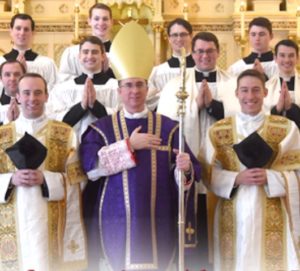
CSPV with new Bishop James Carroll. Will they abandon the Kelly-Jenkins rule to follow Catholic theology and law?
The Future of the Cooties Rule
After thirty years, a new dynamic is at work in SSPV circles. The original organization is now merely a shell: only four of the original priest-members remain, joined later by two priests that Bp. Mendez ordained for it in 1990. SSPV will eventually be replaced by the CSPV — the Congregation of St. Pius V — an organization that Bp. Kelly founded after his consecration that would be subject solely to him.
SSPV and CSPV will no doubt keep the Spiritual Cooties Rule firmly in place until both Bp. Kelly and Fr. Jenkins are dead. Neither man would tolerate abolishing it. So, out of deference, organizational loyalty and a general desire not to rock the boat, none of the younger clergy in the Kelly-Jenkins orbit, I think, would dare to suggest a change, even though some of them by now may have come to question the policy.
On the basis of a conversation with Fr. Kelly more that thirty years ago, however, I suspect he might have anticipated such a possibility by now and tried to prevent it. One day, he told me that if he ever founded a religious congregation for men, he would look for a way to enforce obedience explicitly under pain of mortal sin, either by a vow or by an oath. More vintage Kelly “guilt and fear,” of course.
In the matter at hand, what better way to perpetuate the sacred Spiritual Cooties Rule than to tell gullible young men they must take a vow or swear an oath to enforce it, and that they will then be forever bound to do “under pain of mortal sin”?
But in fact, this would merely be more empty, Wizard-like thunder and fulmination. A supposedly mortal sin-producing vow or oath like this would be invalid and not morally binding for a whole host of reasons. One is that the object of such a vow or oath — the refusal of the Eucharist to someone who had a right to it under both canon law and divine law — is evil. A vow or oath directed to this evil end would have no power to bind from its inception.
And in any case, no traditional Catholic priest or bishop has the right to bind someone to obedience under pain of sin as Fr. Kelly wished to do — neither priest nor nun nor member of the laity. Power like that belongs only to duly constituted ecclesiastical authority.
Nor could whatever other vows one takes in CSPV be bootstrapped into achieving this purpose. The object of such a command would be evil, and a priest would be obliged to disobey such a command. And in the long run, moreover, vows in CSPV have the exactly same status as we outlined above for the Daughters of Mary: they are mere private vows which, like a vow to give up pizza, can be dispensed by any confessor for a sufficient reason.
Despite initial obstacles, however, I am confident that the Cooties Rule will be dropped one day. The process may begin in much the same way that I came to change my assessments of the Mount St. Michael group and the Thuc consecrations.
Some young cleric in the CSPV may come to suspect that the certitudes Bp. Kelly has firmly declared to be founded on Catholic moral theology and canon law may not really be all that certain. Or he may be initially convinced that Bp. Kelly’s position is correct, and want to refute the arguments of, say, the infamous and thoroughly wicked Fr. Anthony Cekada.

The theology and canon law section: fatal to the Cooties Rule.
In either case, if the young man’s Latin is good, he may decide to compare Bp. Kelly’s claims or my own with the teachings of pre-Vatican II theologians and canonists. And then, in some seminary or university library, he will eventually discover, just as I did in the 198os, that the grand principles Clarence Kelly enunciated to accuse people of mortal sin, declare episcopal consecrations doubtful and refuse thousands and thousands of Catholics the sacraments were nothing more than his own inventions, and had no foundation whatsoever in Catholic moral theology or canon law.
Something like this, believe me, will happen one day, simply because the whole, great edifice of Catholic theology and canon law will always be there, along with the tools to understand it, for those priests who are truly determined to do so.
Having discovered the truth, the young man and his fellow clerics will then face a choice: continue to recycle theological myths invented by a “venerated founder” (as SSPX does), or discard what they now know is false, and conform their practice to the dictates of canon law and Catholic moral theology.
For Catholic priests who profess fidelity to the traditions, teachings and laws of the true Church — on this question or any other — it must always be the latter.
If for the good of souls this means a public climbdown by CSPV one day from some Fr. Kelly-generated myth, well so be it. There are a lot of priests who will have proceeded them — Bp. Donald Sanborn, Bp. Daniel Dolan, Fr. Anthony Cekada, Fr. Joseph Collins, Fr. Eugene Berry, Fr. Thomas Zapp, Fr. Denis McMahon and Fr. Daniel Ahern.
For many of us, eschewing the Cooties Rule and other Fr. Kelly myths has allowed us to assist or cooperate with a whole network of sedevacantist clergy throughout the world — America, Canada, Mexico, Brazil, Argentina, England, France, Belgium, Italy, Germany, Austria, Hungary, Poland, Ukraine, Australia and Nigeria — as should be evident from the article here and the photo montage in the video here.
There is no shame in a priest or a professedly Catholic organization undertaking a change of course if it is dictated for serious reasons, whether based on the needs of the Church or even (and especially) the principles of Catholic theology or canon law. This is seen in the history of many pre-Vatican II religious orders, and indeed, even in the history of the CMRI, which was the object of so much of Fr. Kelly’s wrath.
So I, and many others, clerical and lay, hope that a future generation of clergy will have the common sense and the courage to act on what the rest of us have often painfully learned over the years — and that SSPV’s thirty-year-old Spiritual Cooties Rule and the sacramental penalties it imposes on faithful Catholics will, at age forty, no longer see the light of day.